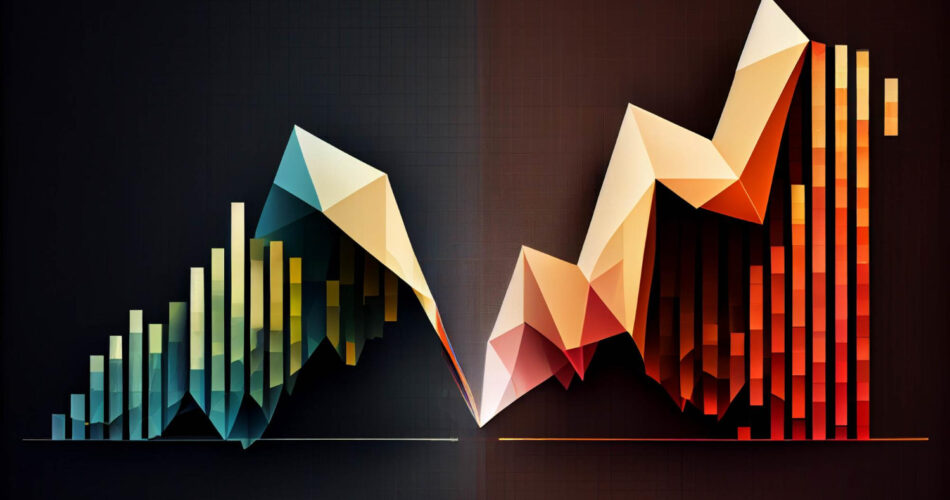In the dynamic world of cryptocurrency trading, understanding the nuances can make the difference between a profitable trade and a missed opportunity. One such nuance is the concept of futures price vs spot price. This article will delve into these two critical concepts, providing you with a comprehensive understanding that could significantly enhance your trading strategy.
Key Takeaways:
- Spot Price and Futures Price: The spot price is the current market price at which a cryptocurrency can be bought or sold for immediate delivery. The futures price is the price agreed upon today for the purchase or sale of a cryptocurrency at a future date.
- Influencing Factors: The spot price is influenced by immediate supply and demand dynamics, while the futures price is influenced by factors like the current spot price, the time until delivery, the risk-free rate of return, storage costs, and expected future market conditions.
- Market Sentiment: The relationship between futures price and spot price can indicate market sentiment. If the futures price is higher than the spot price, it suggests bullish sentiment, while if it’s lower, it suggests bearish sentiment.
- Trading Strategies: Understanding these prices can enhance trading strategies by helping traders anticipate future price movements, manage risk, and identify potential arbitrage opportunities.
- Common Mistakes: Traders often overlook the cost of carry when dealing with futures prices and fail to consider the impact of market volatility. They may also rely too heavily on the futures price as a predictor of future spot price movements.
Table of Contents
Definition of Key Terms

Spot Price: The Current Pulse of the Market
The spot price, in the context of cryptocurrency trading, refers to the current market price at which a particular cryptocurrency can be bought or sold for immediate delivery. It’s essentially a real-time snapshot of the market, reflecting the price that you would have to pay (or receive) if you were to carry out a transaction right now.
The spot price is influenced by a variety of factors. These include the current supply and demand for the cryptocurrency, market sentiment (i.e., the overall attitude of investors towards the market or a particular asset), and current events that may have an impact on the market (such as regulatory news, technological advancements, or macroeconomic factors).
Futures Price: A Glimpse into the Future
The futures price, on the other hand, is the price agreed upon today for the purchase or sale of a cryptocurrency at a future date. Unlike the spot price, which reflects the current market conditions, the futures price is essentially a prediction of what the price will be at a specified point in the future.
The futures price is determined by a number of factors. These include the current spot price, the time remaining until the delivery date, the risk-free rate of return (which reflects the theoretical return of an investment with zero risk), any storage costs, and the expected future market conditions (which can be influenced by factors such as anticipated changes in supply and demand, market sentiment, and future events that are expected to impact the market).
In the world of cryptocurrency trading, understanding the difference between the futures price and the spot price is crucial. The relationship between these two prices can provide valuable insights into market expectations and potential trading opportunities.
Detailed Comparison: Futures Price vs Spot Price
| Comparison Point | Futures Price | Spot Price |
|---|---|---|
| Definition | The price agreed upon today for the purchase or sale of a cryptocurrency at a future date. | The current market price at which a cryptocurrency can be bought or sold for immediate delivery. |
| Calculation | Based on the current spot price, plus the cost of carry (interest rates, storage costs, etc.), minus any expected yield from the asset. | Determined by the immediate supply and demand dynamics in the market. |
| Relationship Indication | If futures price is higher than the spot price (contango), it indicates that the market expects the spot price to rise. If lower (backwardation), it suggests the market expects the spot price to fall. | Spot price reflects the current market sentiment and is the baseline for futures price calculation. |
| Impact of Market Volatility | Increased volatility tends to widen the spread between futures price and spot price due to the increased risk associated with holding the asset until the future date. | Volatility can cause significant short-term fluctuations in the spot price. |
| Use in Trading Strategies | Used to hedge against price risk or speculate on price movements. Can help identify potential arbitrage opportunities or anticipate future price movements. | Used for immediate transactions. Suitable for traders who want to take advantage of short-term price movements. |
Let’s delve deeper into their characteristics and how they interact with each other.
Calculation of Prices
The spot price is the current market price at which a cryptocurrency can be bought or sold for immediate delivery. It’s determined by the immediate supply and demand dynamics in the market.
On the other hand, the futures price is agreed upon today for the purchase or sale of a cryptocurrency at a future date. It’s calculated based on the current spot price, plus the cost of carry (which includes factors like interest rates, storage costs, convenience yield, and any dividends or yield from holding the asset), minus any expected yield from the asset.
Relationship Between Futures Price and Spot Price
The relationship between futures price and spot price can provide valuable insights into market sentiment. If the futures price is higher than the spot price (a situation known as “contango”), it indicates that the market expects the spot price to rise in the future. Conversely, if the futures price is lower than the spot price (a situation known as “backwardation”), it suggests that the market expects the spot price to fall.
Impact of Market Volatility
Market volatility can have different impacts on futures price and spot price. In general, increased volatility tends to widen the spread between futures price and spot price. This is because the risk associated with holding the asset until the future date increases, which is reflected in a higher futures price.
Use in Trading Strategies
Both futures price and spot price play crucial roles in trading strategies. Spot trading involves buying or selling a cryptocurrency for immediate delivery, making it suitable for traders who want to take advantage of short-term price movements.
On the other hand, futures trading allows traders to agree on a price today for delivery at a future date, providing a way to hedge against price risk or speculate on price movements. Understanding the relationship between futures price and spot price can help traders identify potential arbitrage opportunities or anticipate future price movements.
Case Study: Real-world Examples in Crypto Trading

Case Study 1: Bitcoin’s Bull Run
During Bitcoin‘s 2017 bull run, the futures price significantly exceeded the spot price, indicating market optimism about Bitcoin’s future value. This situation is known as “contango” and it suggests that traders expected the price of Bitcoin to continue to rise in the future.
Traders who understood this could have profited handsomely. For instance, they could have bought Bitcoin at the spot price and simultaneously sold Bitcoin futures contracts. Then, when the futures contracts expired, they could have sold their Bitcoin at the higher futures price, making a profit from the difference between the futures price and the spot price.
Case Study 2: The Ethereum Flash Crash
During the Ethereum flash crash of June 2017, the spot price of Ethereum plummeted from over $300 to as low as 10 cents on some exchanges, before quickly rebounding. This was due to a multimillion dollar sell order being placed on the GDAX exchange (exchange ran by Coinbase), which triggered a cascade of stop loss orders and margin calls.
Interestingly, during this event, the futures price of Ethereum remained relatively stable. This discrepancy between the futures price and the spot price could have signaled an opportunity for savvy traders. For instance, they could have bought Ethereum at the low spot price during the flash crash and simultaneously sold Ethereum futures contracts. Then, when the futures contracts expired, they could have sold their Ethereum at the higher futures price, making a profit from the difference.
These case studies highlight the importance of understanding the relationship between futures price and spot price in crypto trading. By keeping an eye on these two prices and understanding what they indicate about market sentiment, traders can identify potential trading opportunities and make more informed trading decisions.
The Role of Futures Price and Spot Price in Crypto Trading Strategy
Understanding the interplay between futures price and spot price can significantly enhance a trader’s strategy in the cryptocurrency market. Here’s how:
Market Sentiment Analysis
The relationship between futures price and spot price can serve as a valuable indicator of market sentiment. If the futures price is higher than the spot price (a situation known as “contango”), it suggests that traders are willing to pay a premium now for the asset in the future, indicating bullish market sentiment. Conversely, if the futures price is lower than the spot price (a situation known as “backwardation”), it suggests bearish market sentiment.
Risk Management
Futures contracts can be used as a risk management tool. If a trader owns a cryptocurrency and fears that its price might fall in the future, they can sell a futures contract at the current futures price. This way, even if the spot price falls in the future, they can still sell their cryptocurrency at the agreed futures price, thus hedging against potential losses.
Arbitrage Opportunities
Differences between futures price vs spot price can sometimes create arbitrage opportunities. For instance, if the futures price is significantly higher than the spot price, a trader could buy the cryptocurrency at the spot price and simultaneously sell a futures contract. When the contract expires, they can sell the cryptocurrency at the higher futures price, making a profit from the price difference.
Speculation
Futures contracts can also be used for speculation. If a trader believes that the price of a cryptocurrency will rise in the future, they can buy a futures contract at the current futures price. If their prediction is correct and the spot price rises above the futures price by the time the contract expires, they can buy the cryptocurrency at the lower futures price and sell it at the higher spot price, making a profit from the price difference.
Expert Opinions

Expert opinions can provide valuable insights into the relationship between futures price and spot price, as well as their implications for the cryptocurrency market. Here are some perspectives from industry experts:
Tom Lee, Co-founder of Fundstrat Global Advisors
Tom Lee is a well-known figure in the cryptocurrency industry and has often spoken about the relationship between futures price and spot price. According to Lee, the futures market can sometimes act as a sort of “crystal ball” that provides insights into future price movements. For instance, if futures prices are consistently higher than spot prices, it could indicate bullish sentiment among institutional investors, which might eventually drive up the spot price.
Paul Eisma, Head of Trading at XBTO Group
Paul Eisma, who leads trading at one of the largest institutional investors in the cryptocurrency space (XBTO Group), has pointed out that the futures market can offer more than just a glimpse into future price movements. It can also provide a measure of the market’s risk perception. For instance, a wide spread between futures price and spot price could indicate high perceived risk, while a narrow spread could suggest low perceived risk.
John Jansen, CEO of Deribit
John Jansen, CEO of Deribit, a leading cryptocurrency derivatives exchange, has highlighted the importance of understanding the technical aspects of futures trading. According to Jansen, traders who understand the mechanics of futures contracts, including how they are priced and settled, can gain an edge in the market.
These expert opinions underscore the importance of understanding the relationship between futures price and spot price in crypto trading. By keeping an eye on these two prices and understanding what they indicate about market sentiment and risk perception, traders can make more informed decisions and potentially increase their profits in the cryptocurrency market.
Conclusion
Understanding the difference around futures price vs spot price is crucial for any crypto trader. These two prices provide a wealth of information about the current state of the market, future expectations, and potential trading opportunities.
The spot price reflects the current market sentiment and is influenced by immediate supply and demand dynamics. It’s the price you would pay (or receive) for immediate transactions, making it crucial for short-term trading strategies.
The futures price, on the other hand, is a prediction of what the price will be at a specified point in the future. It’s influenced by a variety of factors, including the current spot price, the time remaining until the delivery date, the risk-free rate of return, any storage costs, and expected future market conditions. Understanding the futures price can help traders anticipate future price movements, manage risk, and identify potential arbitrage opportunities.
The relationship between these two prices can also provide valuable insights into market sentiment. For instance, if the futures price is higher than the spot price, it could indicate bullish market sentiment, while if it’s lower, it could suggest bearish sentiment.
By leveraging this knowledge, traders can make more informed decisions, anticipate market trends, and potentially increase their profits in the cryptocurrency market. Whether you’re a seasoned trader or just starting out, understanding the interplay between futures price and spot price is a valuable tool in your trading arsenal.
FAQs
What influences the futures price and spot price in crypto trading?
The spot price in crypto trading is influenced by the immediate supply and demand dynamics in the market. It’s the current market price at which a cryptocurrency can be bought or sold for immediate delivery. Factors such as market sentiment, current events, and the overall supply and demand for the cryptocurrency can significantly impact the spot price.
The futures price, on the other hand, is the price agreed upon today for the purchase or sale of a cryptocurrency at a future date. It’s influenced by a variety of factors, including the current spot price, the time remaining until the delivery date, the risk-free rate of return, any storage costs, and expected future market conditions.
How can understanding these prices improve my trading strategy?
Understanding the interplay between futures price and spot price can significantly enhance your trading strategy. For instance, if the futures price is higher than the spot price (a situation known as “contango”), it suggests that traders are expecting the price of the cryptocurrency to rise in the future. This could be a signal to consider buying the cryptocurrency. Conversely, if the futures price is lower than the spot price (a situation known as “backwardation”), it suggests that traders are expecting the price to fall, which could be a signal to consider selling.
Additionally, understanding these prices can help you identify potential arbitrage opportunities. For example, if the futures price is significantly higher than the spot price, you could consider buying the cryptocurrency at the spot price and simultaneously selling a futures contract. When the contract expires, you could sell the cryptocurrency at the higher futures price, making a profit from the price difference.
What are some common mistakes traders make when dealing with these prices?
One common mistake is not taking into account the cost of carry when dealing with futures prices. The cost of carry includes factors like interest rates and storage costs, and it can significantly impact the futures price. Ignoring the cost of carry can lead to inaccurate predictions about future price movements.
Another common mistake is not considering the impact of market volatility. Market volatility can cause significant fluctuations in both futures price and spot price, and it can widen or narrow the spread between these two prices. Ignoring market volatility can lead to missed trading opportunities or potential losses.
Finally, some traders might rely too heavily on the futures price as a prediction of future spot price movements. While the futures price can provide valuable insights into market expectations, it’s not always a reliable predictor of future spot price movements. It’s important to consider other factors, such as market news, technical analysis indicators, and overall market sentiment.


